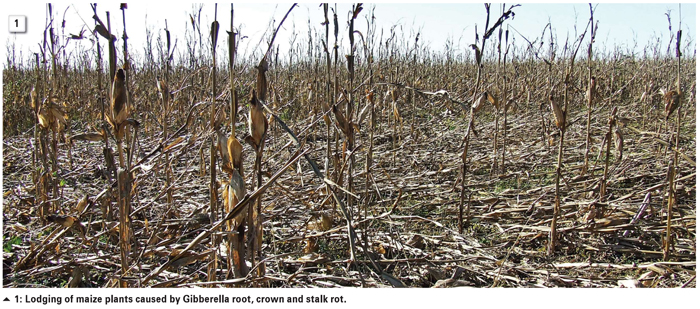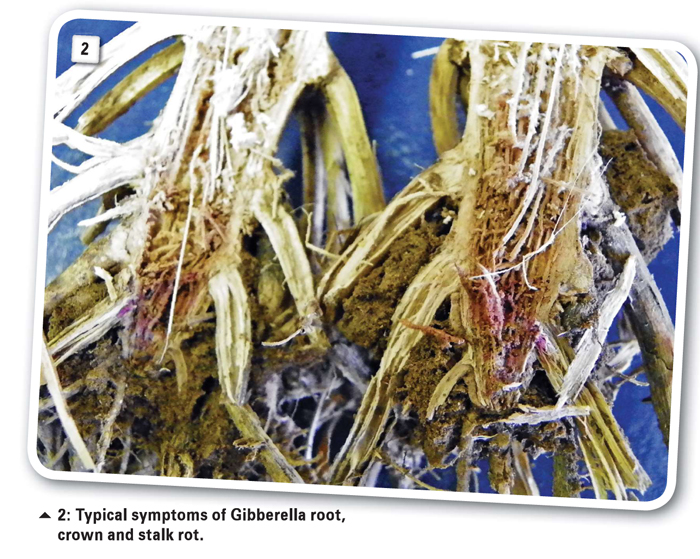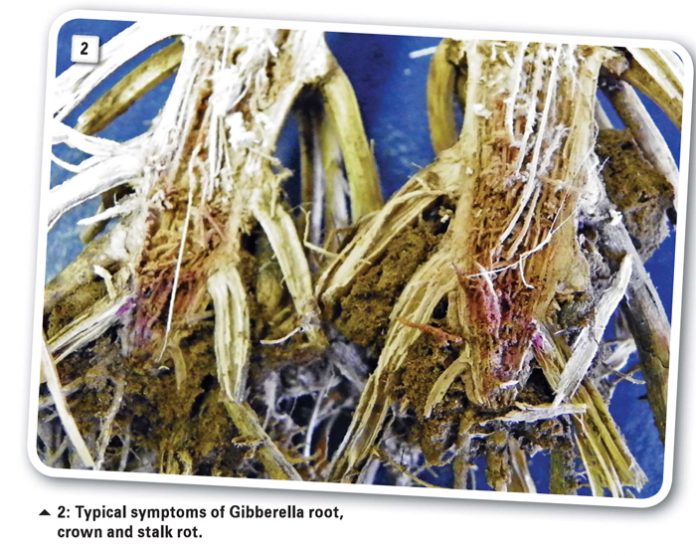May 2018
PROF BRADLEY FLETT and DR BELINDA JANSE VAN RENSBURG, ARC-Grain Crops, Potchefstroom
Gibberella root, crown and stalk rot is caused by the fungal species in the Gibberella zeae (Fusarium graminearum species complex) with the primary hosts other than maize being oats, barley, rye, sorghum and wheat.
Of the 16 species belonging to the Fusarium graminearum species complex worldwide, only three are found on maize in South Africa. These rots are widespread throughout the South African maize production area, but are particularly common in irrigated maize fields. Maize grown in monoculture or in rotation with other graminaceous host crops can increase disease levels.
Economic importance
Gibberella root, crown and stalk rot is a common problem in maize production areas worldwide and also in South Africa particularly where wet, warm favourable conditions persist. It can cause extensive economic losses due to premature plant death and interference with translocation of water and nutrients during grain fill, resulting in lodging of plants due to weakened stems (Photo 1).

Yield loss depends on a number of factors including genotype, prevailing climatic conditions, fertilisation rates, crop density and cultural practices. Although it is difficult to estimate precise yield loss due to Gibberella root, crown and stalk rot during favourable environmental conditions, extensive damage (lodging) is known to occur.
Lodging complicates mechanical operations, necessitating the picking up of plants and hand harvesting, which increase time, labour and financial constraints.
 Symptoms
Symptoms
Symptoms of Gibberella root, crown and stalk rot are similar to those of other root and stalk rots, but it is the pink/red discolouration that is diagnostic (Photo 2). Affected plants wilt, the leaves change from light to dull green and the lower stalks become straw coloured.
Unfortunately, symptoms only become obvious once the damage has been done. To confirm the disease, it is suggested that producers remove an infected plant and cut it lengthwise down the stalk to the root ends.
The tissue should have a red discolouration to it. The internal pith disintegrates, leaving only the vascular bundles intact. The disintegration of stem tissue causes stem lodging and rotting of the root system which leads to root lodging. Small, round, black fruiting bodies (perithecia) may be produced superficially on the stalks, often at the internode.
Epidemiology
Under warm, wet conditions, the perithecia produce ascospores that are disseminated by wind and may infect maize plants. Inoculum may also be produced as conidia during the summer. Stalk infections usually occur shortly after pollination, developing at the origin of the leaf sheaths or around the brace roots. The fungus may also enter through the roots, crowns and grow up into the lower stem.
Control
Crop rotation
Crop rotation with legume crops or sunflowers will allow stubble to break down, without providing a host on which to survive, thereby reducing inoculum. Although recent studies have shown the ability of a number of the Fusarium graminearum complex species to survive on plant organic matter in or on the soil, it is still important to rotate with crops that are non-hosts and break down quickly in the field.
Resistance
Although a lot of effort has been made to select hybrids with root, crown and stalk rot resistance, the main consideration is still yield. Genotypes with higher yields tend to have bigger ears, which act as large sinks for carbohydrates in the plants.
The larger ears result in reduced carbohydrate levels in the lower stem, predisposing the plant to these rots. Therefore, the balance between breeding for resistance to these rots and breeding for high yield is a delicate one.
Nutrients and stress reduction
Cultural practices that reduce plant stress also reduce incidence of stalk rot. Common stress conditions include: High nitrogen, low potassium fertility, high soil moistures in the mid to late season after a dry season, moisture stress early in the season and during grain fill as well as high incidence of leaf diseases.
Physical damage that creates wounds (insects, nematodes, hail) allowing the pathogen to enter the maize plant may also predispose the plant to root, crown and stalk rot. Reducing plant densities will also alleviate plant stress.
Chemical control
There are no fungicides available for the control of Gibberella stalk rot. However, fungicide applications for the control of leaf diseases, may be beneficial in reducing stress on the plant, thus reducing stalk rot severity and ultimately lodging.
 For further information regarding Gibberella root, crown and stalk rots of maize or any other maize diseases, contact Dr Belinda Janse van Rensburg or Prof Bradley Flett at 018 299 6100.
For further information regarding Gibberella root, crown and stalk rots of maize or any other maize diseases, contact Dr Belinda Janse van Rensburg or Prof Bradley Flett at 018 299 6100.
Publication: May 2018
Section: On farm level


















